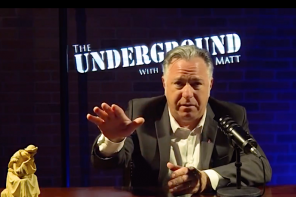The “Synod on Synodality” which Pope Francis launched with minimal fanfare this month is the Vatican’s latest effort to square a circle. It’s meant to engage the whole church, all billion plus, in a process of “walking together” though no one seems to know quite where or how.
Sociologists might observe that many Catholics have already had their own synods and walked right out the door. Casual observers of religion will be forgiven for not knowing what’s going on. Serious students will do well to ask hard questions lest attention and energies be diverted from worthier pursuits. In the spirit of the late feminist philosopher and theologian Mary Daly, it seems more like ‘sinning oddly’ than a synod.
A synod is generally thought of as an assembly or meeting; in the Catholic case, a gathering of bishops who make decisions in a hierarchical church. The Vatican adamantly insists that this Synod is not a place, a thing, or an event. Rather, they call it a process, something on-going in various stages that’s meant to unfold from the ground up. It is said to be inclusive of many and varied persons whose views are taken into account. Unfortunately, there are structural reasons why such a process cannot be realized. Without the full inclusion of women in every aspect of church life there is simply no “walking together.”
Even if a billion people speak, it’s still some fraction of the world’s five thousand bishops who are allowed to vote, and one Pope who will decide the outcome of the process. There is nothing new or ‘synodal’ about that. It just reinforces and reinscribes the hierarchy and keeps most Catholics who are not part of it busy. They may think in good faith that they’re contributing to a collegial process. But with no power to vote, no accountability or transparency on how the input is generated, transmitted, and analyzed, and no say in how conclusions are implemented, this synod is a bad bet for lay people.
It’s a savvy PR move on the part of the institution, a case of its catching up with and trying to coopt the roiling movements of people away from institutional Catholicism to more—pardon the term—“synodal” ways of being church. As far as I know, no budget figures are public. How is this work being financed, especially in poor countries?
One diocesan media person told me that there was no budget for this project as there are no new costs involved. I can believe it; a sign of how insignificant it is, or how many people are rattling around chanceries waiting for something to do. In any case, the Vatican-requested ten-page-report-per-diocese doesn’t leave much room for depth or detail, and offers a ready excuse for why certain, shall we say, sticky wicket issues will probably not see the light of day.
At a time when the institutional church’s prestige is in the cellar—ask the hundreds of thousands of victims of clergy sexual abuse in France, just to take a small sample—it’s obvious why some in the Vatican, including Pope Francis, want to change the rhetoric and iconography. One more photo of robed bishops gathered in a synod is not the answer to their prayers. But this hybrid process runs the real risk of instrumentalizing people, and distracting from important work for justice when there’s no sign of structural change in the works.
Even the title of this project is dubious: A Synod on Synodality. Many an English teacher taught students not to write things like “a walk on walking,” or “a meeting on meetings.” The fuzzy factor is a dead giveaway to an unthought out idea.
No one I know has actually read the Preparatory Document, For a Synodal Church: Communion, Participation, Mission,” much less the VADEMECUM, or Handbook, that serves as the how-to guide. Something about the bright colors and whimsical drawings in these documents—the graphics of the little children leading the way are too cute by half. It gives the impression that this is a process run by media people with little thought to how it will change anything. Perhaps that’s because it’s not meant to change anything foundational.
Color me skeptical, but language like “journeying companions,” “co-responsible in mission,” and “common obedience to the Spirit” bear little resemblance to reality. Such spiritualized, stylized, not to say slippery, phrases make for wonderful copy. But they bear no resemblance to a church in which women are categorically prohibited from priesthood and therefore almost all decision-making; in which LGBTIQ+ people are seen as products of “gender ideology” and unfit for sacramental marriage and employment in many Catholic institutions; where divorced and remarried people are not welcome to share communion; where women who have abortions or become priests are excommunicated. With whom are we companions and co-responsible—and who obeys whom?
The ‘process’ calls for local churches to share their insights with their dioceses, then dioceses and other selected groups (for example, religious congregations through their leadership conferences, theological faculties through God knows whom) share their syntheses with their respective episcopal conferences. Resulting documents will be discussed in seven continental meetings of bishops, then refined into a final working document to be discussed by the bishops at the Assembly of the Synod of Bishops in 2023. Who’s missing from that picture? Women and non-clerics to start.
The primary contradiction is that the synodal process is taking place in a kyriarchal—that is, a top-down church—fraught with intersecting forms of oppression. “Walking together,” while it sounds nice, is virtually impossible without substantive structural changes. As currently structured, some Catholics, namely the clergy, will walk on beautifully groomed paths. They will stroll along and glide into the best seats.
Most women, LGBTIQ+ people, divorced and remarried Catholics, and other persons may be on the same path but with enormous boulders, even mountains in their way. And most people will have neither time, energy, health, nor inclination to step a foot along a path they do not choose, to a destination they cannot pick, with people who do not stop long enough to bid them the briefest greeting much less change the framework so they can participate as equals.
Recent synods, for example, in 2014 on the family, in 2018 on youth, and in 2019 in the Pan Amazon region do not inspire any confidence that this one will be any better, just a scaled-up version of the same. For example, there were high hopes for the Amazonian Synod with a Latin American pope. But the well-documented requests for women to be included in ordained ministry and for married men to be ordained as priests all evaporated when votes were taken and the papal document emerged. What would motivate these people whose hopes were dashed to start all over again, to take the same bait about being included, and be given stones when they asked for bread?
One novelty in the current mix is that French Sister Nathalie Becquart, who is an undersecretary of the Synod of Bishops, may be the first woman to vote at a Synod. That is far from a done deal, but since the person in her position has typically been a bishop and voted there is some talk of her actually doing the same.
The Plenary Council in Australia is a kind of prototype for this global process. It began in 2016 in the thick of the sexual abuse problems there, and will end in 2022 with a second gathering of delegates before the global Synod of Bishops in 2023. If reports of the Australian gathering’s shortcomings are any indication, there are several predictable problems in the global process.
There’s no mechanism and less trust for assuring that the issues raised by those who participate will be included in the reports. Australian experts say that early indications were that issues related to women and LGBTIQ+ people trended in discussion, but there’s little evidence of that in the working document. It does include an extraordinary understatement: “the perceived underrepresentation of women in formal leadership and decision-making roles is a challenging issue for many in Australia” (paragraph 55).
Perceived?
Moreover, delegates to that assembly from at least one Australian diocese were limited to employees of the archdiocese or scholars from Catholic universities. We might well anticipate that the bishops from around the world who will be chosen as delegates to the 2023 assembly will be of a certain stripe as well.
One synod enthusiast spoke recently about the value of the process and how, despite its shortcomings, people should enter wholeheartedly. He recommended calling one’s local bishop’s office to inquire about where and when one could attend a listening session. To be sporting, I called the local bishop where I live, the Archbishop of Washington DC. His office kindly directed me to the Office of Social Concerns where I was greeted by a recording. Twice I left my name, number, and email address but received no response.
Finally, in reply to my later email, I was directed to three local parishes in my zip code to find out about attending their listening sessions. A priest from one of the three I contacted replied courteously but had to report that the parish has nothing in place yet. He assured me that they would do whatever the diocese instructed.
A recent survey by America magazine staff confirmed my suspicions that the process is off to a rocky start:
“Of the 196 churches contacted by America Media over the last month, 105 did not respond for comment. (Among these were three churches that were contacted late in the process. This article will be updated to reflect their responses.) Of the 91 that did, the vast majority had planned an opening Mass, about two-thirds had appointed a local coordinator, and 35 had a plan in place for reaching out to parishes and gathering feedback. Despite Vatican instructions that ‘special care should be taken to involve those persons who may risk being excluded: women, the handicapped, refugees, migrants, the elderly, people who live in poverty, Catholics who rarely or never practice their faith, etc.,’ only a handful described plans to specifically reach out to those groups.”
I’m not advising friends, especially those who aren’t connected to parishes, to keep their phones open.
At their last meeting in June 2021, the US Catholic Bishops did not discuss the Synod at all, even though they knew it was scheduled to start four months later. They’ve set aside a full forty-five minutes on the agenda of their November 2021 meeting to discuss what’s promoted as the most life-changing process for the Catholic community worldwide since Vatican II. There is a deep disconnect here between rhetoric and reality.
Many bishops, especially the most conservative, are simply ignoring or, it is rumored, dissing the whole thing, perhaps considering it more of Francis’ folly. Others are mounting middling efforts. Still others are giving it the old college try. This Synod may be a case of the tail wagging the dog if lay Catholics take it more seriously than the clerics who are in charge.
Smart clerics, both progressive and conservative, realize that in the best of all possible worlds the outcome would be to disempower them of their clericalism and develop a more horizontal church. They’re acting accordingly: conservatives hoping to run out the clock on Francis’ papacy and progressives proceeding, but with characteristic caution.
Scant financial resources, little popular enthusiasm, and the structural impossibility of squaring the kyriarchal circle all but guarantee that the Synod on Synodality won’t change much of anything. This latest Catholic shiny new object is tarnished before it sees the light of day. My hope is that it doesn’t so distract people from the serious work of feeding the hungry, welcoming immigrants, safeguarding the environment, and eradicating injustice that it adds insult to injury. That would be to sin oddly indeed.





